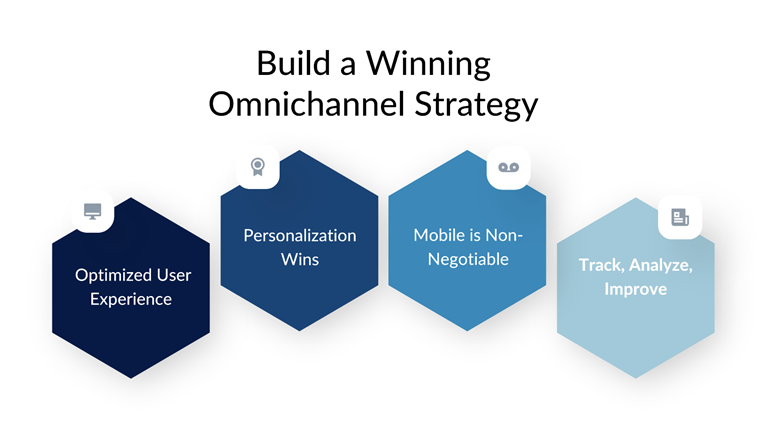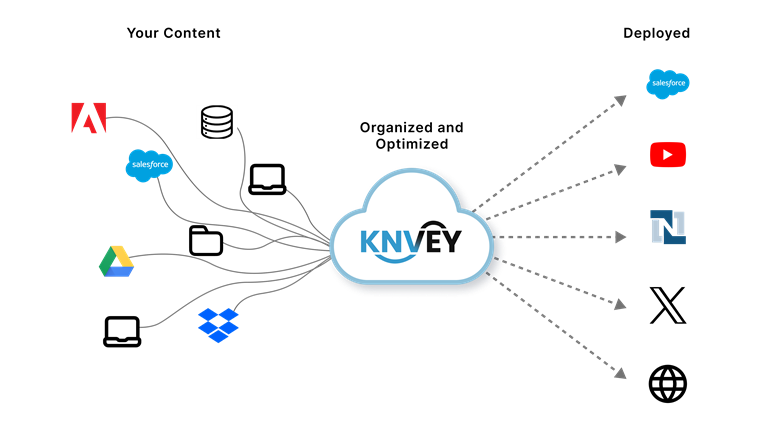Today’s customers interact with brands across multiple digital touchpoints, from websites and mobile apps to social media and email. If your content isn’t consistent, optimized, and connected, you could be losing engagement, trust, and revenue.
Many businesses unknowingly make critical content strategy mistakes that lead to poor customer experience, lower conversion rates, and inconsistent brand messaging. Let’s break down seven common content mistakes, and how you can fix them to create a seamless omnichannel content marketing strategy that drives engagement and revenue.
1 Treating Every Platform the Same
The Mistake:
Copy-pasting the same digital content across all platforms without adapting it for each channel’s audience and format.
Example: Posting a long-form blog article on LinkedIn without summarizing key takeaways or optimizing it for LinkedIn’s audience preferences.
How to Fix It:
- Customize content for each platform’s best practices while maintaining a unified message.
- Repurpose high-quality content by turning blog posts into LinkedIn carousels, short-form videos, or infographics.
- Use an omnichannel content management system (CMS) like KNVEY to organize and distribute content efficiently.
2 Ignoring Customer Behavior Across Digital Channels
The Mistake:
Assuming customers engage with content in a linear path, when in reality, they move between multiple platforms before making a decision.
Example: A customer might see your product on Instagram, research it on Google, then complete a purchase via your mobile website, but if your content isn’t connected, they may drop off.
How to Fix It:
- Use customer journey analytics tools to track multi-channel engagement and identify behavior patterns.
- Implement consistent omnichannel messaging to ensure customers can pick up where they left off.
- Leverage AI-driven content recommendations (like KNVEY’s smart tagging) to serve relevant content based on user interactions.
3 Inconsistent Branding and Messaging Across Platforms
The Mistake:
Your brand looks and sounds different across various digital channels, creating brand confusion and trust issues.
Example: Your website content is formal and professional, but your email marketing uses an overly casual tone, leading to a fragmented brand identity.
How to Fix It:
- Create a brand style guide to maintain consistent messaging, tone, and visual branding across all platforms.
- Use a digital experience platform (DXP) like KNVEY to manage assets, templates, and content variations.
- Conduct regular content audits to ensure brand consistency across your blog, social media, website, and ads.
4 Not Personalizing Content for Different Customer Segments
The Mistake:
Delivering generic, one-size-fits-all content instead of personalized digital experiences that match customer interests and behaviors.
Example: Sending identical marketing emails to all subscribers instead of segmenting by preferences or purchase history.
How to Fix It:
- Use AI-powered personalization software to create dynamic content that adapts based on user behavior.
- Implement customer segmentation to deliver tailored recommendations across emails, landing pages, and in-app messaging.
- Leverage KNVEY’s AI-powered tagging system to surface relevant content based on past interactions.
5 Neglecting Mobile Content Optimization
The Mistake:
Prioritizing desktop content without ensuring a seamless mobile-first experience—resulting in higher bounce rates and lost conversions.
Example: A blog post loads perfectly on desktop, but on mobile, the text is tiny, images are cropped, and the CTA buttons are hard to click.
How to Fix It:
- Implement mobile-first design principles—optimize fonts, images, and navigation for smaller screens.
- Test content across multiple devices to ensure a responsive user experience.
- Use a content delivery network (CDN) like KNVEY’s media management to improve page load speed and performance.
6 Not Tracking Content Performance & Optimization
The Mistake:
Publishing content without measuring its impact, leading to wasted effort and poor ROI.
Example: Posting weekly blog content without tracking which articles drive the most organic traffic and engagement.
How to Fix It:
- Use SEO content analytics tools to monitor page views, click-through rates, and conversions.
- A/B test different content formats and headline variations to optimize engagement.
- Leverage AI-powered insights (like KNVEY’s analytics tools) to refine your content strategy based on real data.
7 Failing to Integrate a Digital Experience Platform (DXP) for Content Management
The Mistake:
Manually managing content across multiple channels, leading to workflow inefficiencies, version control issues, and inconsistent updates.
Example: Updating product descriptions separately on your website, mobile app, and social media instead of using a single source of truth.
How to Fix It:
- Implement a DXP like KNVEY to centralize and automate content management across all platforms.
- Use content automation tools to sync updates instantly across websites, apps, and marketing materials.
- Streamline workflow and collaboration so teams can work from a single content hub instead of managing updates manually.
Fix These Content Mistakes & Build a High-Performing Omnichannel Strategy
A disconnected content strategy leads to poor customer engagement, missed revenue opportunities, and weak brand loyalty. By addressing these seven common mistakes, you can create a seamless, omnichannel digital experience that boosts conversions and customer retention.
Key Takeaways:
- Optimize content for each platform instead of copy-pasting.
- Maintain brand consistency with unified messaging across all digital channels.
- Use AI-driven personalization to improve engagement and relevancy.
- Ensure mobile-first design to reach users on any device.
- Measure and analyze content performance to refine your strategy.
- Centralize content management with a DXP like KNVEY for seamless distribution.
The Future of Omnichannel Content: What’s Next?
The digital experience landscape is evolving at an unprecedented pace. As consumer expectations rise and technology advances, businesses must stay ahead of the curve to maintain engagement and deliver seamless content experiences. Omnichannel content strategies are no longer just about being present on multiple platforms—they must now be intelligent, predictive, and deeply personalized.
So, what does the future of omnichannel content look like? Let’s explore the key trends shaping the next era of digital content.
AI-Powered Content Automation
Artificial intelligence is revolutionizing content creation, distribution, and personalization. Businesses are increasingly leveraging AI-driven tools to:
- Automate content recommendations based on user behavior
- Generate personalized messaging tailored to individual preferences
- Optimize content delivery across multiple platforms in real time
What This Means for Businesses:
Brands must invest in AI-driven content management systems (CMS) and DXPs to streamline content operations, improve efficiency, and enhance user engagement.
Predictive Analytics for Hyper-Personalization
Consumers expect brands to anticipate their needs before they even express them. With predictive analytics, businesses can analyze past user interactions to:
- Deliver content at the right time, on the right platform
- Offer highly personalized product recommendations based on browsing and purchase history
- Optimize engagement strategies by predicting when and where users are most active
What This Means for Businesses:
Traditional segmentation is no longer enough. The future demands AI-driven personalization that dynamically adapts to each user’s journey in real-time.
The Rise of Interactive & Immersive Content
Static content is losing engagement power. Consumers want interactive, immersive experiences that allow them to engage with brands in new ways. Emerging trends include:
- Augmented Reality (AR) product previews and interactive storytelling
- Conversational AI (chatbots, voice assistants) for personalized interactions
- Interactive video content, quizzes, and guided product discovery
What This Means for Businesses:
Investing in engagement-driven content formats will be critical. The brands that embrace interactivity will see higher conversion rates and stronger brand loyalty.
Omnichannel Voice Search & Smart Assistants
Voice search and smart assistants like Siri, Alexa, and Google Assistant are changing the way people consume content. Businesses need to optimize for voice-driven interactions by:
- Structuring content with natural language and conversational keywords
- Creating voice-friendly content that can be read aloud in a compelling way
- Ensuring their omnichannel strategy includes smart devices and voice assistants
What This Means for Businesses:
A strong voice search optimization strategy is no longer optional—it’s a necessity for brands looking to remain competitive in a voice-first digital landscape.
Data Privacy & the Cookie-less Future
With increasing regulations like GDPR, CCPA, and the phase-out of third-party cookies, businesses need to rethink how they collect and use customer data. The future of privacy-first omnichannel content will focus on:
- First-party data collection through direct user engagement
- Consent-based personalization, letting users control how their data is used
- AI-driven contextual targeting as an alternative to cookies
What This Means for Businesses:
Brands must adopt transparent data practices and invest in first-party data strategies to maintain trust and personalization in a privacy-conscious world.
Preparing for the Next Era of Omnichannel Content
The future of omnichannel content is about more than just being everywhere—it’s about being intelligent, predictive, and user-centric. Businesses that embrace AI, hyper-personalization, immersive experiences, and privacy-first strategies will thrive in the evolving digital landscape.
Key Takeaways:
- AI-powered automation will streamline content creation & delivery
- Predictive analytics will drive hyper-personalized experiences
- Interactive and immersive content will boost engagement
- Voice search will shape content consumption habits
- Data privacy will reshape how businesses approach personalization
Now is the time to future-proof your content strategy! Is your brand ready?






